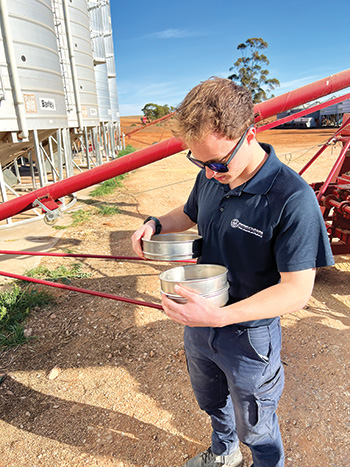 South Australian grains biosecurity officer (PIRSA) Jordan Scott sieving stored grain for insects. Photo: Plant Health Australia
South Australian grains biosecurity officer (PIRSA) Jordan Scott sieving stored grain for insects. Photo: Plant Health Australia
As pests such as weevils and other stored-product beetles become less susceptible to phosphine, there is growing concern over its future effectiveness as a primary fumigant for stored grain in Australia.
Phosphine resistance typically develops from sublethal phosphine treatments, which can occur in unsealed silos or storage areas or when incorrect phosphine treatment periods and concentrations are administered, resulting in a suboptimal or sublethal dose.
Consequently, more insects carrying resistance genes survive, increasing the chances of encountering other insects with weak resistance, which can result in offspring developing strong resistance.
Repeating this process over consecutive seasons can lead to a high proportion of strong phosphine-resistant stored-grain insects. A similar situation can be observed in weed populations, such as fleabane, which have developed resistance to glyphosate, highlighting shared challenges across different agricultural sectors.
National resistance monitoring
Australia’s reputation as a supplier of high-quality grain depends on the continued effective management of stored-grain pests. Along with best practice farm hygiene, the grains industry has recognised that a resistance monitoring program is essential to its grains management strategy.
Recently, South Australian grains biosecurity officer (GBO) Jordan Scott and New South Wales Department of Primary Industries and Regional Development (DPIRD) technical officer Andre Bannink collected stored-grain insects from SA, Victoria and NSW. This activity forms part of the National Program for Monitoring Resistance in Insect Pests of Stored Grain, supported by GRDC.
While collecting stored-grain insects for phosphine resistance bioassays, the program also provides identification and management guidance to bulk handlers and individual growers and aims to survey at least 100 farms per year across those three states. Separate teams in Queensland and Western Australia carry out similar activities.
All major stored-grain beetle pests are tested for resistance, including saw-toothed grain beetle, lesser grain borer, red flour beetle, flat grain beetle (including rusty grain beetle) and rice weevils. A smaller selection of collected samples are also evaluated for resistance to Spinosad. Survey data is used to identify trends in resistance and direct future research.
Preventing phosphine resistance
Growers play a crucial role in preventing resistance in stored-grain insects by ensuring they follow label instructions and only fumigate in gas-tight, sealable storages. Gas-tight silos are essential for maintaining a lethal concentration of phosphine for the required period to eliminate all life stages of grain insects, including species with weak resistance and most with strong resistance. However, alternative treatment is necessary for rusty grain beetles with strong resistance.
In contrast, non-gas-tight silos allow phosphine to escape, reducing the effectiveness of treatment. This is particularly notable for eggs and pupae, which have a higher tolerance for phosphine. Maintaining the gas at a lethal concentration for the required duration ensures all life stages are 100 per cent controlled and preserves the long-term effectiveness of phosphine for pest control in stored grain.
Key recommendations
- Testing – ensure that sealable silos are pressure-tested prior to fumigation to check their integrity (see ‘More information’ below).
- Fumigation administration – administer phosphine according to the label directions to ensure lethal concentrations are maintained long enough for effective control of all insect life stages. Under phosphine label regulations, a ‘fumigation in progress’ warning sign must be displayed. A sign is available for download from the Farm Biosecurity website (see ‘More information’).
To protect the harvest effectively, growers are encouraged to follow best practices in farm hygiene, routinely test silos, use the correct phosphine concentrations for the correct duration and properly identify insects to help target the most appropriate control methods.
For a free stored-grain insect identification booklet or advice on stored-grain insect management and farm biosecurity, contact your local GBO.
Launched in 2007, the Grains Farm Biosecurity Program (GFBP) is managed by Plant Health Australia and funded by growers through Grain Producers Australia.
The GFBP is an initiative to improve the management of, and preparedness for, biosecurity risks in the grains industry at farm and industry levels.
Visit the GFBP website, grainsbiosecurity.com.au, for helpful fact sheets, videos, how-to guides, online courses and strategies to help you improve your biosecurity practices. Growers are also encouraged to contribute voluntary stored-grain samples to the National Program for Monitoring Resistance in Insect Pests of Stored Grain.
More information: Andre Bannink, andre.bannink@dpi.nsw.gov.au
Read also:

























































